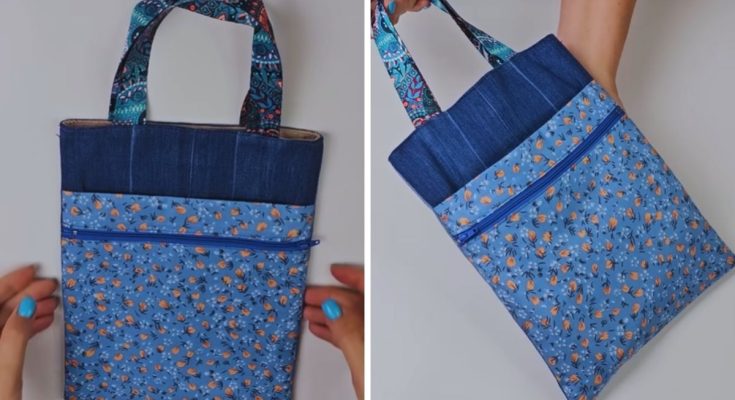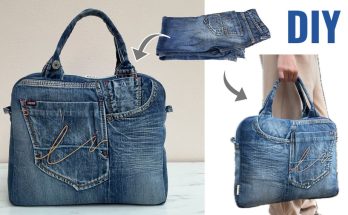You’re looking to whip up a beautiful, functional handbag with three pockets in just one evening? That’s a fantastic goal, and totally achievable with some smart planning and efficient sewing! We’ll focus on a design that’s quick to construct by leveraging a simple tote shape, adding an internal slip pocket, and making two of the pockets super easy by using existing jean pockets. This method helps you create a stylish bag without getting bogged down in complex steps.
We’ll aim for a finished size of approximately 12 inches wide x 13 inches tall x 4 inches deep (30.5 cm W x 33 cm H x 10 cm D), a great size for everyday essentials.
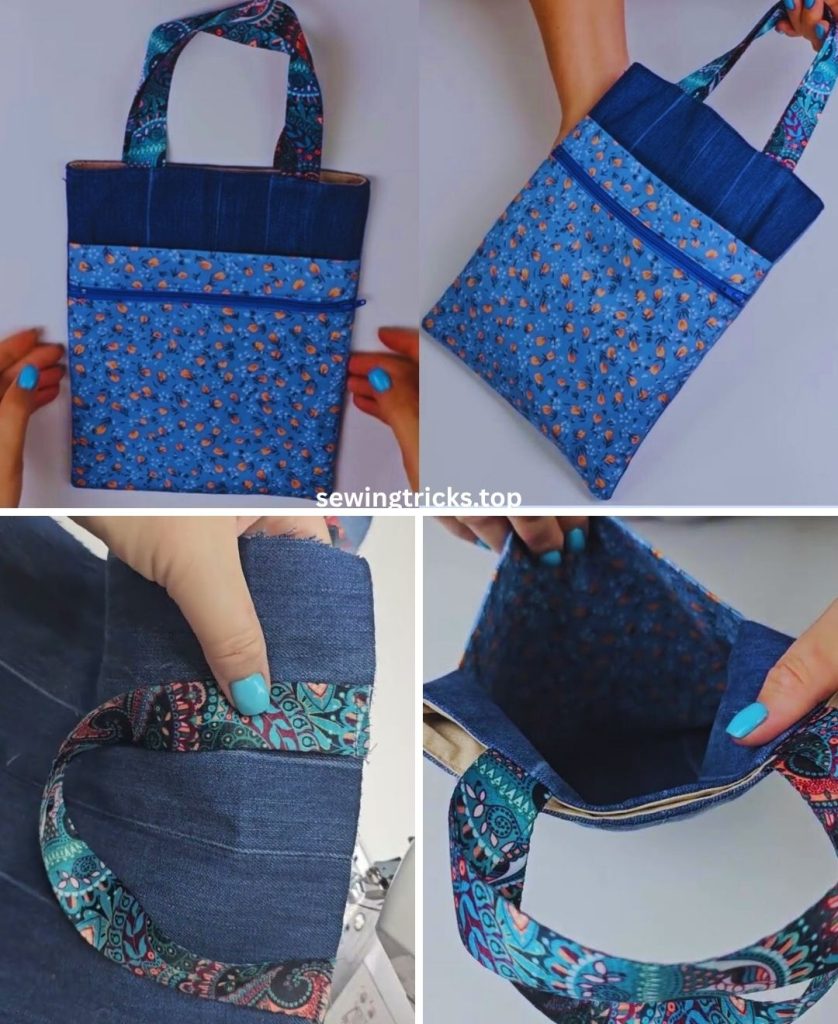
How to Sew a Beautiful Handbag with 3 Pockets in One Evening
I. Getting Ready: Your Quick-Sew Strategy
To make this happen in a single evening, we’re going for efficiency and simplicity.
- Fabric Choice is Key: While you can use a variety of sturdy fabrics, denim from old jeans is perfect because it’s durable and you can easily repurpose its existing back pockets for two of your three pockets. This saves a huge amount of time! If you’re not using jeans, you can still follow along; you’ll just create two simple patch pockets for the exterior.
- Structured Finish: We’ll use heavyweight fusible interfacing to give your bag body and a professional, non-floppy look. This is crucial for a “beautiful” bag.
- Simple Pockets: You’ll have two exterior pockets (the repurposed jean pockets or simple patch pockets) and one interior slip pocket.
- Basic Construction: We’ll use a straightforward tote bag structure with a flat, boxed bottom and an open top (or a simple magnetic snap if you have one handy and want a quick closure).
II. Gather Your Materials (for Speed!)
Having everything prepped and on hand is vital for a smooth, quick sew.
- Main Fabric: 1 large pair of clean, ironed, sturdy denim jeans (non-stretch or low-stretch are best) with two intact back pockets OR 1 yard (0.9 meters) of canvas, duck cloth, or other heavy-weight fabric.
- Lining Fabric: 1 yard (0.9 meters) of medium-weight quilting cotton or broadcloth.
- Heavyweight Fusible Interfacing: 1 yard (0.9 meters) (e.g., Pellon 809 Decor Bond or Pellon 71F Peltex II Ultra Firm).
- Matching Thread: All-purpose polyester thread. If using denim, consider topstitching thread (gold, orange, or beige) for a classic jean look on visible seams.
- Optional: 1 set of magnetic snap (1/2″ or 3/4″) for the top closure.
- Essential Sewing Tools:
- Sewing Machine: With a denim needle (90/14 or 100/16) installed (if using denim) and a walking foot attached (highly recommended for thick fabrics!).
- Sharp Fabric Scissors or Rotary Cutter and Mat.
- Long Quilting Ruler or Measuring Tape.
- Fabric Chalk, Frixion Pen, or Mark-B-Gone Pen.
- Plenty of Wonder Clips (they’re far superior to pins for thick denim and multiple layers!).
- Iron and Ironing Board (absolutely crucial for fusing interfacing and pressing seams flat).
- Seam Ripper (your essential helper for denim deconstruction and any quick fixes!).

III. Prepare & Cut Your Fabric Pieces (Efficiently!)
Pre-cutting is the biggest time-saver for an “evening sew.” If you can, do this step beforehand!
- Target Finished Bag Size: 12″ W x 13″ H x 4″ D (30.5 cm W x 38 cm H x 10 cm D).
- Seam Allowance: We’ll use a consistent 1/2-inch (1.27 cm) throughout.
A. Deconstruct Your Jeans & Harvest Pockets (If Using Denim):
- Cut Off Legs: Lay your jeans flat and smooth. Cut straight across both pant legs, just below the crotch seam.
- Open Leg Seams: Use your seam ripper to carefully open up both the inseam (inner leg seam) and the outseam (outer leg seam) of each cut-off leg. This gives you large, flat panels of denim. Iron these flat to remove creases.
- Carefully Remove Back Pockets: Using your seam ripper, gently detach the two back pockets from the jeans. Go slowly to avoid tearing the surrounding fabric. Set these aside – they are your first two pockets!
B. Calculate & Cut Your Panels:
- Main Body Panel Width Calculation: Finished Width + Finished Depth + (2 * Seam Allowance) = 12″ + 4″ + 1″ = 17 inches (43.2 cm)
- Main Body Panel Height Calculation: Finished Height + Finished Depth + (2 * Seam Allowance) = 13″ + 4″ + 1″ = 18 inches (45.7 cm)
- Exterior Main Fabric Pieces:
- Main Body (Front & Back): Cut 2 rectangles, each 17 inches wide x 18 inches high.
- Quick Tip (if using jeans): You’ll almost certainly need to piece together sections of your opened jean legs to get these large panels. Join denim pieces with a 1/2″ seam, press open, and topstitch on the right side for a polished, durable look.
- Handle Pieces: Cut 2 rectangles, each 4 inches wide x 25 inches long. (Adjust length if you prefer shorter/longer handles). Again, piece from fabric scraps if necessary.
- Main Body (Front & Back): Cut 2 rectangles, each 17 inches wide x 18 inches high.
- Lining Fabric Pieces:
- Main Body (Front & Back): Cut 2 rectangles, each 17 inches wide x 18 inches high.
- Interior Slip Pocket (Your 3rd Pocket!): Cut 1 rectangle, 8 inches wide x 10 inches high.
- Heavyweight Fusible Interfacing:
- Main Body Panels: Cut 2 rectangles, each 16 inches wide x 17 inches high. (Cut them 1 inch smaller on all sides than your main fabric panels. This prevents bulk in your seam allowances).
IV. Let’s Start Sewing Your Handbag (Evening-Friendly Steps!)
General Sewing Tips for Denim & Heavy Fabrics:
- Press, Press, Press: This is the most crucial step for a crisp, professional-looking bag. Press seams flat and open after each stitching step to reduce bulk.
- Backstitch: Always backstitch at the beginning and end of every seam to secure your stitches.
- Use Your Walking Foot: If your machine has one, use it! It makes sewing through thick denim and multiple layers so much easier and prevents fabric shifting.
- Wonder Clips: Use them generously! They hold thick layers better than pins, especially when dealing with denim and interfacing.
- Go Slow: Take your time over bulky seams. Don’t force your machine, as this can lead to skipped stitches or broken needles.
- Topstitching: When called for, use a slightly longer stitch length (3.0-3.5mm) for a more pronounced and professional topstitch.
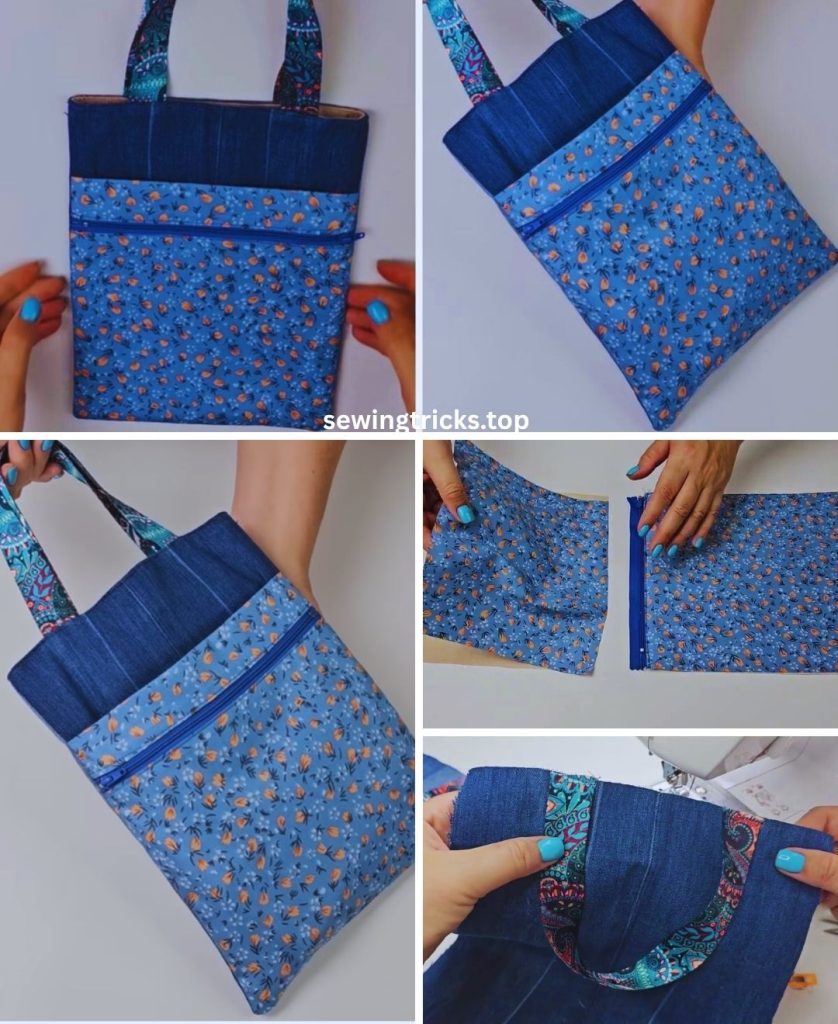
Step 1: Fuse Interfacing & Prepare Pockets
- Fuse Interfacing: Lay your two Exterior Main Body Panels wrong side up on your ironing board. Center and fuse the corresponding interfacing pieces to them, following the manufacturer’s instructions. Press firmly and let them cool completely.
- Prepare Interior Slip Pocket (Pocket #3):
- Take your 8″ x 10″ lining pocket piece. Fold one long 8-inch edge down by 1/2″ (1.27 cm) towards the wrong side and press. Fold it down again by another 1/2″ and press. Stitch this double-folded hem in place, sewing close to the inner fold. This is the neat top edge of your pocket.
- Fold the remaining three raw edges (the two short 10-inch sides and the bottom 8-inch side) in by 1/2″ (1.27 cm) and press.
- Position this prepared pocket onto the right side of one Lining Fabric Main Body Panel. Center it horizontally, and place its top edge about 4-5 inches (10-12.7 cm) down from the top raw edge of the lining panel.
- Topstitch the pocket in place along its two sides and bottom edge, sewing close to the folded edges. Backstitch securely at the beginning and end. For added durability, reinforce the top corners of the pocket opening with a small triangle stitch or extra back-and-forth stitches.
- Attach Exterior Jean Pockets (Pockets #1 & #2 – if using denim):
- Take your two Exterior Main Body Panels (with interfacing fused, right side up).
- Position a salvaged jean pocket onto the lower center of each panel. Leave about 3-4 inches (7.6-10 cm) from the bottom raw edge of the panel and center it horizontally.
- Topstitch each pocket onto its denim panel along its two sides and bottom edge, sewing close to the original stitching lines on the pocket. Ensure the top opening of the pocket remains open!
- Reinforce the top corners of each pocket opening with a small triangle or X-box stitch for durability, as these pockets will see a lot of use.
- (If not using jean pockets, create two simple patch pockets from your exterior fabric, hem their top edges, fold in sides/bottom, and topstitch them onto your exterior panels in a similar fashion.)
Step 2: Prepare and Attach Fabric Handles
- Prepare Handles: Take one Handle Piece (4″ x 25″). Fold it in half lengthwise, wrong sides together, and press firmly along the fold. Open up the strip. Now, fold each long raw edge in towards the center crease you just made, and press again. Fold the entire strip in half again along the original center crease. You should now have a long, flat handle that is about 1 inch (2.5 cm) wide, with all raw edges neatly enclosed. Press firmly along the entire length to set the folds.
- Topstitch down both long sides of the prepared handle, about 1/8″ (0.3 cm) from the edge. Use topstitching thread if desired for a more pronounced look. Repeat for the second handle.
- Attach to Exterior Panels: Lay one Exterior Main Body Panel (with pocket, right side up). Measure in from each side edge about 4-5 inches (10-12.7 cm) along the top raw edge of the panel. Mark these points with fabric chalk.
- Position the raw ends of one prepared handle at these marks, pointing downwards into the bag. Clip securely.
- Stitch the handle ends in place using an X-box stitch (sew a square, then an “X” inside it) for maximum reinforcement. Perform this stitching within the 1/2-inch (1.27 cm) seam allowance, close to the raw edge. This reinforcement is crucial as the handles will bear the weight of the bag’s contents. Repeat for the second exterior panel with the second handle.
Step 3: Sew the Bag Body (Exterior and Lining)
- Exterior Bag: Pull your two Exterior Main Body Panels (with handles and pockets attached) together so they are right sides together. The handles should be tucked neatly inside. Clip along both side edges and the entire bottom edge.
- Stitch from one top corner down that side, pivot sharply at the bottom corner, stitch straight across the bottom, pivot again, and stitch up the other side to the top corner. Backstitch at the beginning and end of your seam.
- Press all seams open thoroughly to reduce bulk.
- Lining Bag: Pull your two Lining Fabric Main Body Panels (one with the slip pocket) together so they are also right sides together. Clip along both side edges.
- Crucial Turning Opening: For the bottom seam of the lining, you’ll need to leave an opening for turning the bag right side out. Stitch approximately 3 inches (7.6 cm) from one side along the bottom edge, then leave a 4-6 inch (10-15 cm) unstitched gap in the middle. Backstitch well at the start and end of your stitching around this gap. Finish stitching the rest of the bottom seam. Stitch up the second side seam.
- Press all lining seams open.
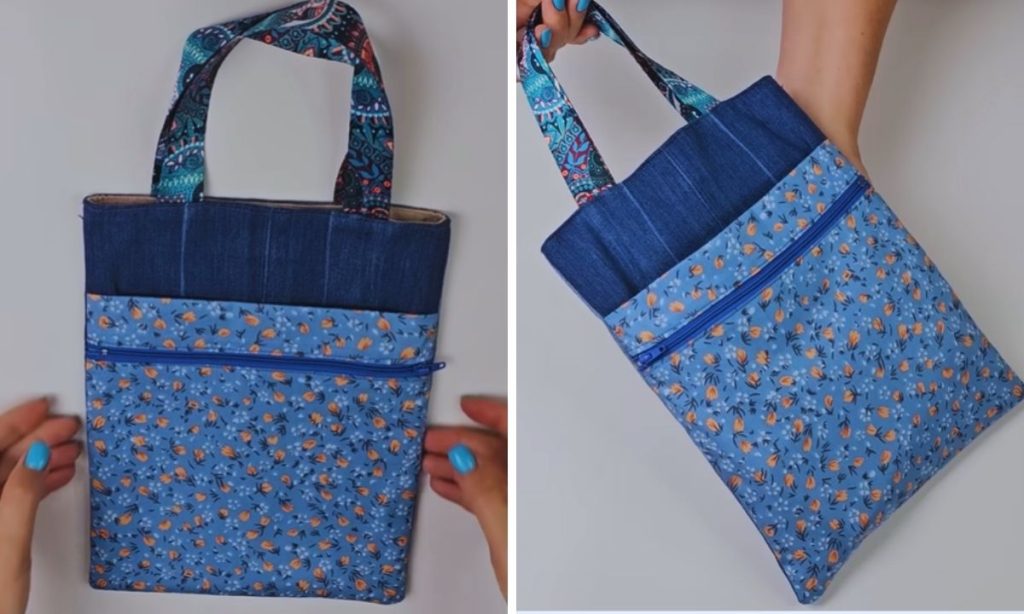
Step 4: Box the Corners (Exterior and Lining)
This step creates the flat, defined bottom of your tote bag, giving it shape and stability.
- At one of the bottom corners of the exterior bag, carefully bring the side seam and the bottom seam together, aligning them perfectly. This action will naturally form a triangular shape at the corner.
- Measure from the tip of this triangle inward along the seam line a distance equal to half of your desired bag depth (e.g., for a 4-inch deep bag, you’ll measure 2 inches / 5 cm).
- Draw a straight line perpendicular to the seam at this measured point. (This line will be 4 inches long if your desired depth is 4 inches).
- Clip firmly along this drawn line.
- Stitch precisely along the drawn line, backstitching securely at both ends.
- Trim the excess fabric from the corner, leaving about a 1/2-inch (1.27 cm) seam allowance beyond your new stitching line.
- Repeat this exact process for all three remaining corners: the other exterior corner and both lining corners.
- Result: Both your exterior fabric bag and your lining bag now have structured, flat bottoms. Keep the exterior bag right side out and the lining bag wrong side out.
Step 5: Final Assembly (The “Bag-in-a-Bag” Method)
This is a clever technique that encloses all raw edges at the top of your bag, resulting in a very clean and professional finish.
- Carefully insert the exterior bag (which is right side out, with handles pointing down inside) into the lining bag (which is wrong side out and has the turning opening).
- The right sides of both bags should now be facing each other.
- Align the side seams of the exterior bag with the side seams of the lining bag.
- Align the top raw edges of the exterior fabric and the lining fabric all around the entire opening of the bag. The handles should be tucked well inside between the layers.
- Clip very securely all the way around this top opening, matching up seams precisely.
- Stitch all the way around the entire top opening of the bag, using a 1/2-inch (1.27 cm) seam allowance. Go slowly and carefully, especially over the thick areas where the handles are attached. Backstitch at the beginning and end of your seam.
- Trim Bulk: Carefully trim the seam allowance at the top down to about 1/4 inch (0.6 cm) to reduce bulk inside the top edge for a smoother finish.
Step 6: Turn Your Bag Right Side Out & Finish!
This is the incredibly satisfying moment your handmade bag takes its final, beautiful shape!
- Remember that opening you left in the bottom seam of the lining in Step 3? Reach through it.
- Slowly and carefully pull the entire bag (exterior, lining, handles – everything!) through this opening until it is completely right side out. Take your time, gently pushing out all the corners and seams for a crisp, well-defined shape.
- Close the Lining Opening: Go to your ironing board. Press the raw edges of the opening in the bottom of the lining under by 1/2 inch (1.27 cm) so they meet neatly. Align these pressed edges and clip them together. Stitch this opening closed by machine (sewing very close to the folded edge for a neat finish) or by hand using an invisible ladder stitch for a truly seamless look.
- Now, gently push the lining down into the exterior bag, ensuring it sits smoothly inside and the top edges are even.
- Final Press & Topstitch: Carefully press the entire top edge of the bag, ensuring the lining is fully tucked inside and isn’t peeking out over the top edge of the exterior fabric.
- For a super polished and durable finish, topstitch all around the entire top opening of the tote, sewing about 1/8 inch (0.3 cm) from the edge. This final topstitching marries the lining to the exterior, helps the bag hold its shape, and creates a crisp, professional look. You can also sew a second row of topstitching about 1/2 inch (1.27 cm) from the top edge for added detail and stability.
- Optional Magnetic Snap: If you decided to add a magnetic snap for closure, now is the time to install it. Typically, you’d place one half on the interior lining of the front, and the other on the interior lining of the back, centered about 1-2 inches down from the top edge. Follow the snap’s specific instructions for attachment.
You did it! Your beautiful, functional, and quickly-made handbag with three pockets is complete. You’ve created a unique and practical accessory, all in one evening!
What kind of fabric did you use, and how do those three pockets make your life easier?

